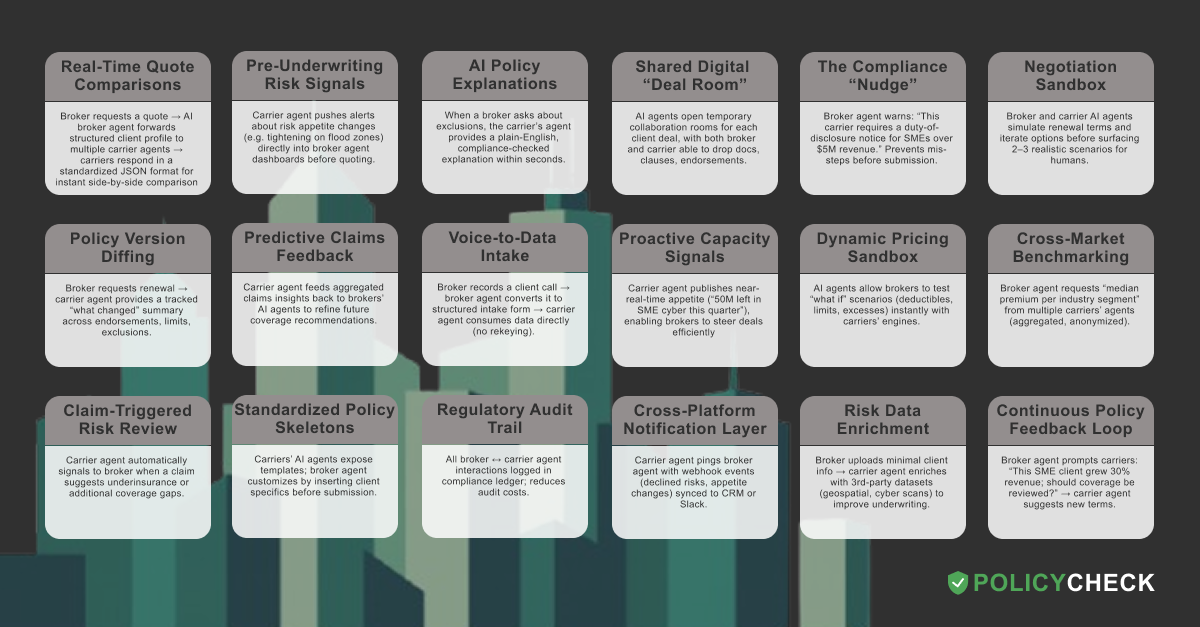Our Case Studies

Real-world examples of how PolicyCheck transforms insurance workflows, improves compliance, and accelerates adviser–carrier collaboration. These case studies highlight measurable efficiency gains, from cutting policy review times to reducing compliance risks. They also demonstrate how smarter automation builds stronger, more transparent client relationships while unlocking new growth opportunities for advisers and carriers alike.
1. Real-Time Quote Comparisons
Brokers can instantly request and compare quotes across multiple carriers in a standardized format. This removes delays caused by manual rekeying and provides clients with transparent, side-by-side comparisons.
- Standardized JSON responses from carriers
- Instant side-by-side quote comparison
- Faster client decision-making
2. Pre-Underwriting Risk Signals
Carrier AI agents push proactive risk signals to brokers before a quote is requested. These signals help brokers anticipate carrier appetite changes such as geographic restrictions or exposure tightening.
- Alerts for appetite changes (e.g., flood zones)
- Delivered directly into broker dashboards
- Prevents wasted time on non-viable quotes
3. AI Policy Explanations
When brokers encounter exclusions or complex policy language, carrier AI agents generate plain-English, compliance-checked explanations instantly, reducing misunderstandings.
- Simplifies complex insurance language
- Ensures explanations are compliance-checked
- Improves broker–client communication
4. Shared Digital Deal Room
Temporary digital collaboration rooms allow brokers and carriers to manage a deal jointly, with live document sharing and tracked edits. This ensures alignment and faster deal cycles.
- One central workspace per client deal
- Upload, track, and version documents easily
- Faster turnaround and fewer email chains
5. The Compliance Nudge
AI proactively warns brokers about compliance requirements, such as disclosure obligations for certain client types. This prevents compliance errors before submission.
- Prevents regulatory missteps
- Provides context-specific compliance prompts
- Reduces rejected submissions
6. Negotiation Sandbox
AI simulates policy renewal scenarios and negotiation strategies, surfacing realistic options for brokers and carriers to consider before client presentation.
- Runs multiple renewal term simulations
- Provides 2–3 realistic options for humans
- Improves efficiency of negotiations
7. Policy Version Diffing
At renewal, carrier agents generate a detailed ‘what changed’ summary highlighting differences in terms, exclusions, and endorsements, saving brokers hours of manual comparison.
- Automated change tracking across versions
- Clear client-ready summaries
- Reduces errors in renewal discussions
8. Predictive Claims Feedback
Carrier agents analyze claims trends and feed insights back into brokers’ recommendations, allowing brokers to refine coverage advice before issues arise.
- Aggregated claims insights shared proactively
- Improves accuracy of coverage advice
- Helps mitigate emerging risks early
9. Voice-to-Data Intake
Brokers can record client calls and have them converted directly into structured intake forms. Carrier AI agents consume the data without rekeying, reducing admin work.
- Turns calls into structured, usable data
- Removes need for manual rekeying
- Accelerates submission turnaround
10. Proactive Capacity Signals
Carriers publish near real-time signals about available underwriting capacity (e.g., SME cyber insurance limits). Brokers use this to target viable deals efficiently.
- Capacity alerts shared before quoting
- Prevents chasing unavailable cover
- Improves placement efficiency
11. Dynamic Pricing Sandbox
AI lets brokers test multiple what-if pricing scenarios instantly with carrier engines, helping identify the best fit for the client in real time.
- Instant deductible/limit scenario testing
- Direct connection to carrier pricing engines
- Faster tailored pricing recommendations
12. Cross-Market Benchmarking
Brokers can request industry-segment median pricing and coverage benchmarks aggregated across carriers, providing powerful negotiation leverage.
- Aggregated and anonymized benchmarks
- Shows premium trends per industry segment
- Strengthens client presentations
13. Claim-Triggered Risk Review
When claims data suggests underinsurance or coverage gaps, carrier AI automatically signals the broker to review the policy with the client.
- Early detection of underinsurance risks
- Prevents repeat claims issues
- Enhances client protection proactively
14. Standardized Policy Skeletons
Carriers expose base policy skeletons, which brokers can customize for clients by inserting specific details. This reduces friction in preparing submissions.
- Reusable templates streamline submissions
- Reduces duplicate admin effort
- Improves broker productivity
15. Regulatory Audit Trail
All broker–carrier interactions are logged in a compliance-ready audit trail. This reduces audit costs while ensuring every action is traceable.
- Complete compliance history auto-generated
- Reduces regulatory overhead
- Protects brokers during audits
16. Cross-Platform Notification Layer
Carrier AI sends real-time webhook events (declined risks, appetite changes) directly into brokers’ CRM or Slack, keeping teams in sync automatically.
- Instant notifications across platforms
- Integrates with brokers’ existing tools
- Reduces missed opportunities
17. Risk Data Enrichment
Minimal client data is enriched by AI with third-party datasets (cyber scans, geospatial data), enhancing underwriting accuracy and lowering carrier risk.
- Automated enrichment with external datasets
- Improves risk profiling
- Supports more accurate pricing
18. Continuous Policy Feedback Loop
Carrier AI prompts brokers when client growth or business changes suggest that coverage may need to be reviewed, enabling proactive engagement.
- Monitors client changes (e.g., revenue growth)
- Prompts proactive broker outreach
- Ensures clients stay adequately covered
